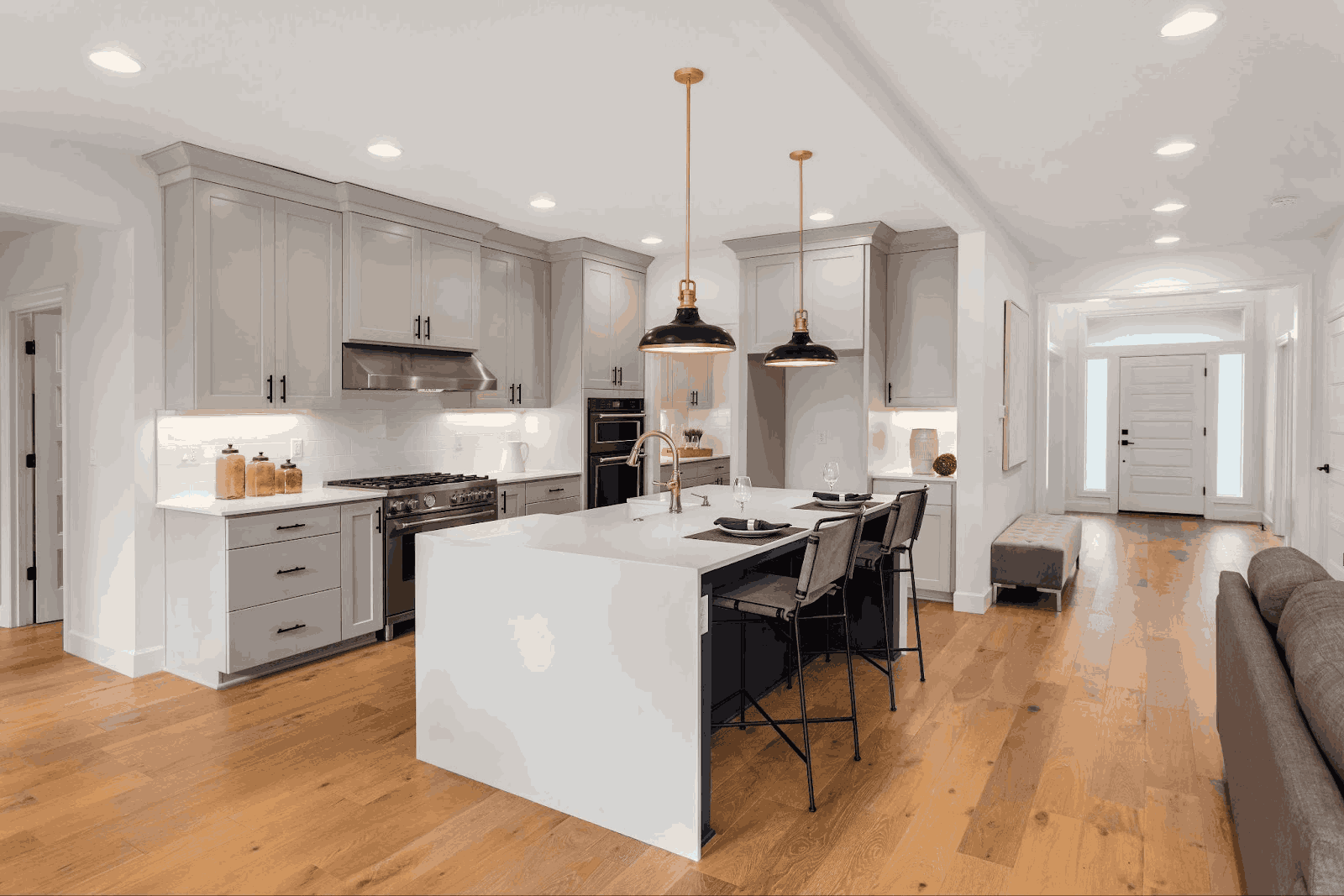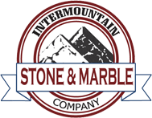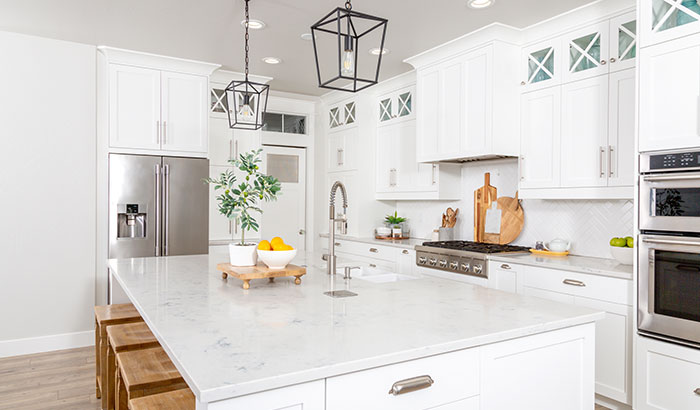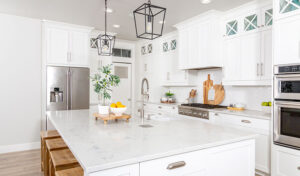The kitchen is the heart of any home, and a well-designed kitchen can greatly enhance the overall look and feel of the space. Kitchen countertops are an essential component of any kitchen design, providing a functional workspace while also adding a touch of style and sophistication.
Choosing the right countertop for your kitchen is one of the most important decisions you will make during the remodeling or designing process. The countertop is not only a functional element of the kitchen, but it also plays a crucial role in determining the overall style and ambiance of the space.
The right countertop can create a stunning visual impact and elevate the overall design of your kitchen while also providing practical benefits such as durability, ease of maintenance, and more. Additionally, the countertop is one of the most frequently used surfaces in the kitchen, making it essential to select a material that can withstand daily wear and tear while still looking beautiful for years to come.
Popular Kitchen Counter Trends
Over the years, there have been various trends in countertop designs, with each era having its unique style and design elements. Here are some popular kitchen trends from the past few decades:
1980s – The 1980s were all about bold colors and patterns, with pastel shades and floral prints being popular. Laminate countertops were common, and appliances were often brightly colored.
1990s – In the 1990s, neutral colors were more prevalent, with beige, cream, and taupe being popular choices. Granite countertops began to gain popularity, and stainless steel appliances became a must-have in modern kitchens.
2000s – The 2000s saw a move towards minimalist designs, with clean lines and simple color schemes. Black and white kitchens were popular, and natural materials such as wood and stone were widely used.
2010s – The 2010s saw a rise in open-concept kitchen designs, with islands and peninsulas becoming popular. Quartz countertops began to replace granite, and stainless steel appliances continued to be in demand.
2020s – In recent years, there has been a move towards warmer and more natural designs, with earthy tones and organic materials becoming popular. Smart home technology is also being incorporated into kitchen designs, with appliances and lighting being controlled through smartphones and voice assistants.
Kitchen design trends have evolved significantly over the past few decades. However, the one constant has been the importance of functionality and durability, with homeowners looking for materials and designs that look good and provide practicality and longevity.
One of the latest trends that will continue to be popular for years to come is the waterfall countertop.
In this blog, we aim to provide a comprehensive guide to waterfall countertops, starting with their description — what they are, how they differ from traditional countertops, and how they can enhance the look and feel of your kitchen. We will also delve into the practical advantages of waterfall countertops, such as their durability and long-lasting quality, as well as their potential to increase the value of your home.
Additionally, we will explore the various materials commonly used for waterfall countertops, including their unique properties and advantages. Finally, we will discuss the installation process for waterfall countertops, including the importance of hiring a professional installer to ensure a perfect fit and flawless finish.
By the end of this blog, you will have a solid understanding of all the essential aspects of waterfall countertops and be better equipped to make an informed decision for your kitchen renovation project.
What Is A Waterfall Countertop?
A waterfall countertop is a type of countertop that extends vertically down the sides of a kitchen island or peninsula, creating a seamless flow of material. This design element gives the countertop the appearance of a “waterfall,” hence its name.
Unlike traditional kitchen countertops that have a visible seam or edge where the countertop surface ends, waterfall countertops wrap around the sides of the island or peninsula, creating a continuous, uninterrupted flow. This modern waterfall edge design has become increasingly popular in recent years due to its sleek and sophisticated appearance.

Benefits of Waterfall Countertops
The benefits of waterfall countertops go beyond aesthetics. There are many practical advantages to choosing a waterfall countertop for your kitchen. From their durability and long-lasting quality to the added value they bring to your home, there are many reasons why a waterfall countertop may be the perfect addition to your kitchen design.
Here are just a few of the most common benefits:
- Aesthetically Pleasing: Aesthetically, a waterfall countertop can transform the look and feel of your kitchen. It creates a seamless flow from the countertop to the vertical sides of the island or peninsula, giving your kitchen a modern and sophisticated appearance. The uninterrupted flow of material draws the eye and adds a sense of elegance to the overall design.
- Durable: Waterfall countertops are known for their durability and longevity, making them a great investment for any kitchen. The use of thicker slabs of material makes the countertop less prone to cracking, chipping, or other damage. Moreover, the seamless design eliminates the need for seams or grout lines that can become weak points prone to cracking or staining.
Additionally, many materials used for waterfall countertops, such as granite and quartz, are highly resistant to scratches and heat damage, ensuring they will look great for many years to come. With proper care and maintenance, a waterfall countertop can last for decades, providing both functionality and beauty to your kitchen.
- Adds Value to Your Home: Waterfall countertops are a popular design trend that has gained traction in recent years. As such, they have become a highly sought-after feature in modern homes. If you plan to sell your home in the future, installing a waterfall countertop can add significant value to your property. This is because potential homebuyers are often willing to pay more for a home that has modern and stylish features, and a waterfall countertop fits the bill perfectly.
Moreover, a waterfall countertop can be a unique selling point, setting your home apart from others on the market. So, not only does a waterfall countertop add to your kitchen’s aesthetics and functionality, but it can also increase the overall value of your home.
- Hides Cabinet Storage: One of the practical benefits of a waterfall countertop is its ability to conceal cabinet storage underneath. This is particularly useful for kitchens with limited space or where a cluttered appearance is not desired. The continuous flow of the material creates a clean and streamlined look that complements any modern or minimalist design.
Waterfall countertops can be customized to fit the height and length of your kitchen island or peninsula, allowing you to choose the perfect amount of cabinet storage to suit your needs. Additionally, using thicker slabs of material in waterfall countertops means that they can support heavier items without the need for additional support or brackets, making them a practical storage solution for your kitchen
Materials for Waterfall Countertops
The material you choose for your waterfall edge countertop can greatly impact its overall look and durability. Each material has its own unique characteristics, such as durability, natural beauty, and ease of maintenance. We’ll delve into the benefits and drawbacks of each material to help you make an informed decision when choosing the perfect material for your kitchen’s waterfall countertop.
Some of the most common materials include:
- Granite: Granite is a popular choice for waterfall countertops due to its durability, natural beauty, and range of colors and patterns.
- Marble: Marble offers a classic and elegant look in a wide range of colors and patterns. However, it is more susceptible to scratching and staining than other materials.
- Quartz: Quartz is a popular choice for waterfall countertops due to its durability, low maintenance, and wide range of colors and patterns.
- Wood: Wood adds warmth and texture to a kitchen and is a popular choice for waterfall countertops. However, it requires more maintenance than other materials, such as sealing and periodic oiling.
Installation Process
Installing a waterfall countertop is a more involved process than a traditional countertop due to its unique design. It requires precise measurements, cutting, and fitting of the countertop material to create a seamless flow from the horizontal surface to the vertical sides. This process involves more time and skill than installing a standard countertop.
The thickness of the material is also an important consideration. While a traditional countertop is typically 1.5 inches thick, a waterfall countertop is usually 2-3 inches thick or even thicker for more dramatic designs. This added thickness requires special attention to ensure the weight is properly supported.
The installation process for a waterfall countertop is more complex than a traditional countertop installation.
Here are the steps involved:
- Measurements: The first step is to take precise measurements of the kitchen island or peninsula, including the vertical edges.
- Material Selection: Next, the countertop material is selected. This material should be thicker than a traditional countertop, usually 2-3 inches thick, and may require special support to handle the additional weight.
- Cutting and Fitting: The countertop material is then cut and fitted to the exact measurements of the kitchen island or peninsula. This process includes cutting and shaping the material to fit the vertical edges seamlessly.
- Support and Installation: Once the countertop material is cut and fitted, it is time for support and installation. The weight of a waterfall countertop requires additional support, so a professional installer will use specialized brackets or other support systems to ensure the countertop is safely and securely installed.
- Finishing: Finally, the waterfall countertop is polished and finished to ensure a seamless and beautiful appearance.
Hiring an experienced and skilled professional to install your waterfall countertop is crucial. A professional installer will have the expertise and tools needed to accurately measure and cut the material to fit your kitchen island or peninsula perfectly. With a flawless finish, your new waterfall edge countertop will be a stunning addition to your kitchen.
Intermountain Stone & Marble
If you’re in the market for a stunning and durable waterfall countertop, look no further than Intermountain Stone & Marble. Our team of skilled professionals offers an extensive range of materials, including granite, marble, quartz, and porcelain, ensuring that we have the perfect countertop to suit your style and budget. With our commitment to delivering top-notch materials at affordable prices, you can trust us to provide you with a beautiful and long-lasting countertop that will elevate your kitchen’s overall aesthetic.
To learn more about our products and services or to request a free quote, contact us today at (801) 266-4241 or visit our website to view our collection of color and style options. We’re excited to work with you and install a gorgeous countertop in your Utah home.


